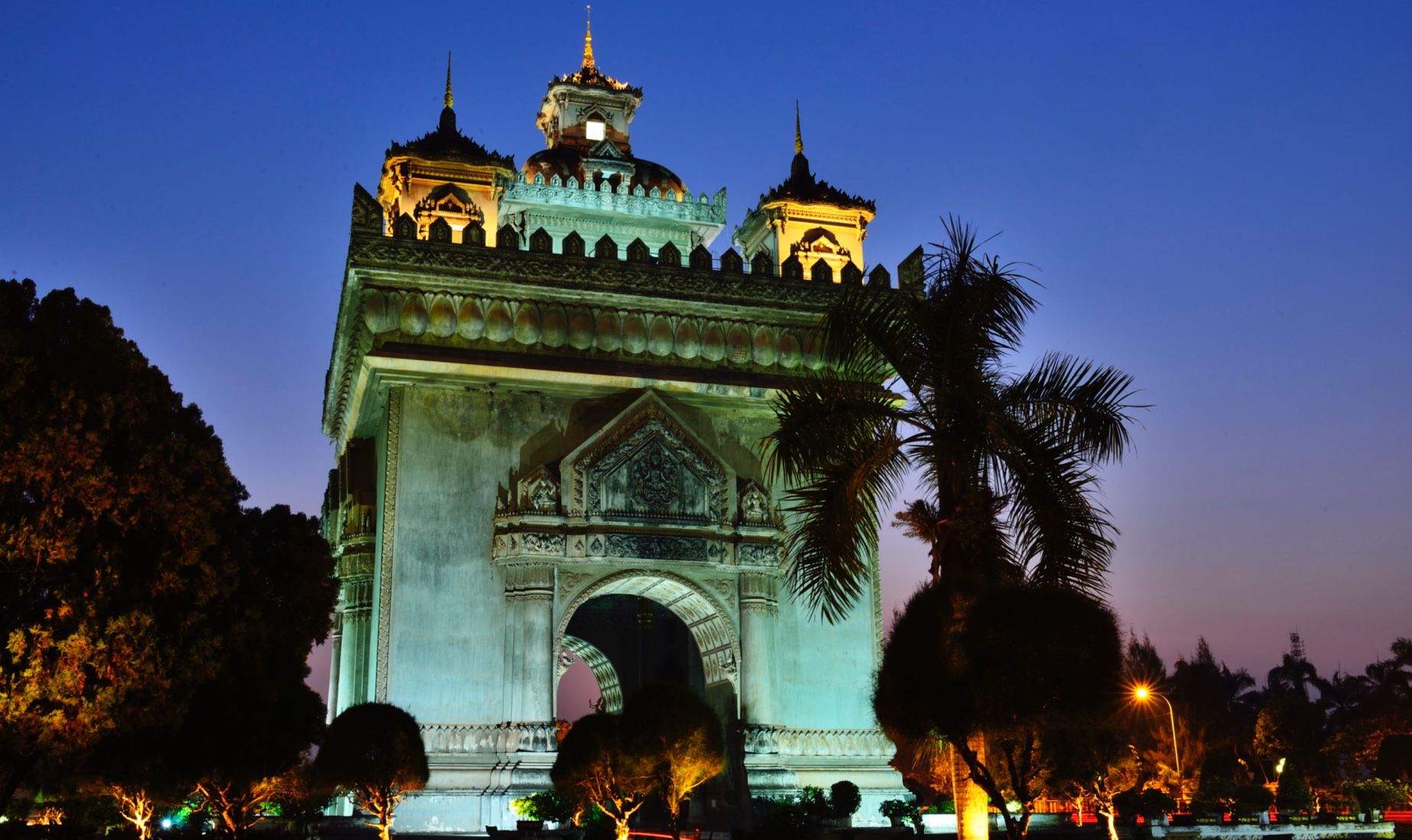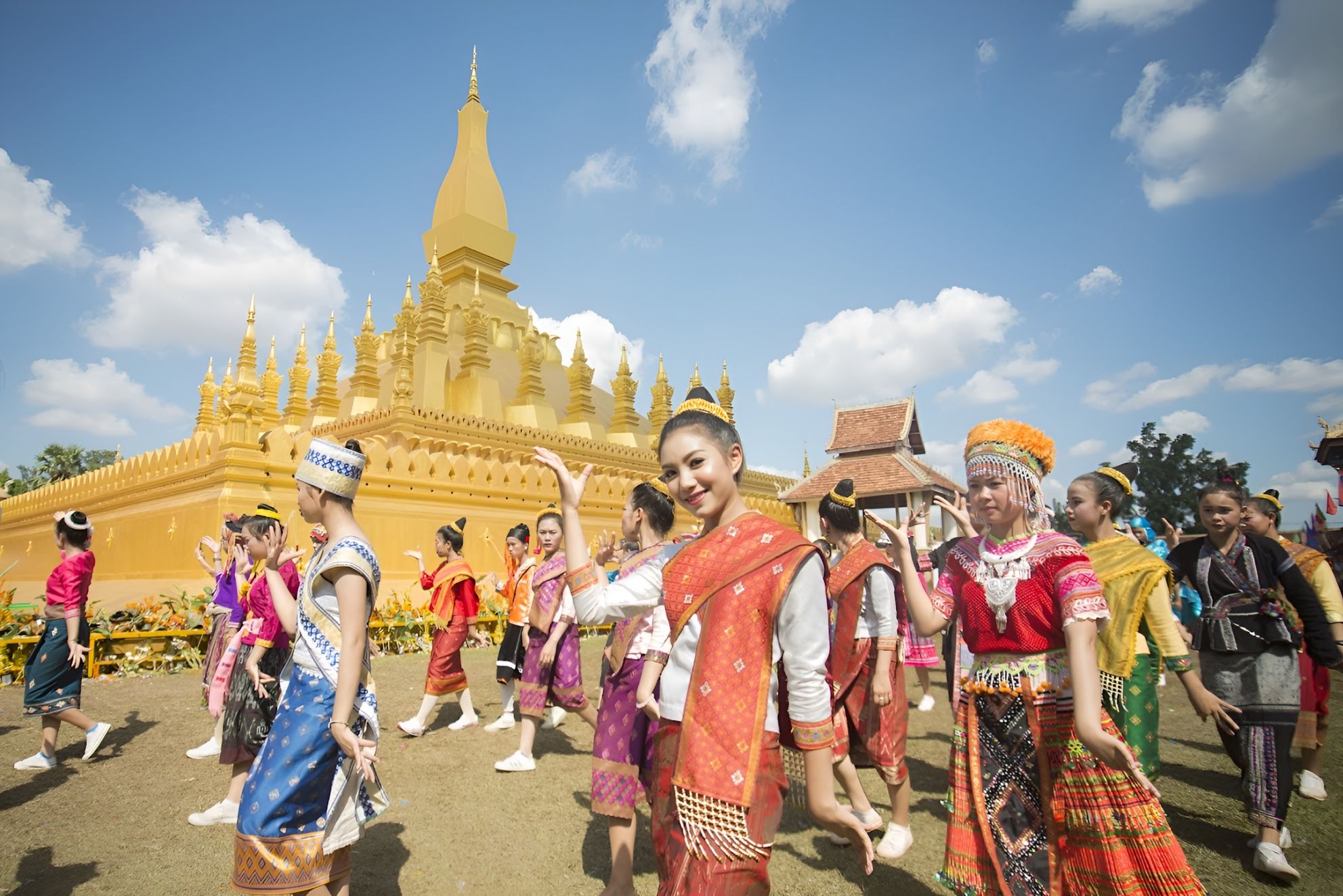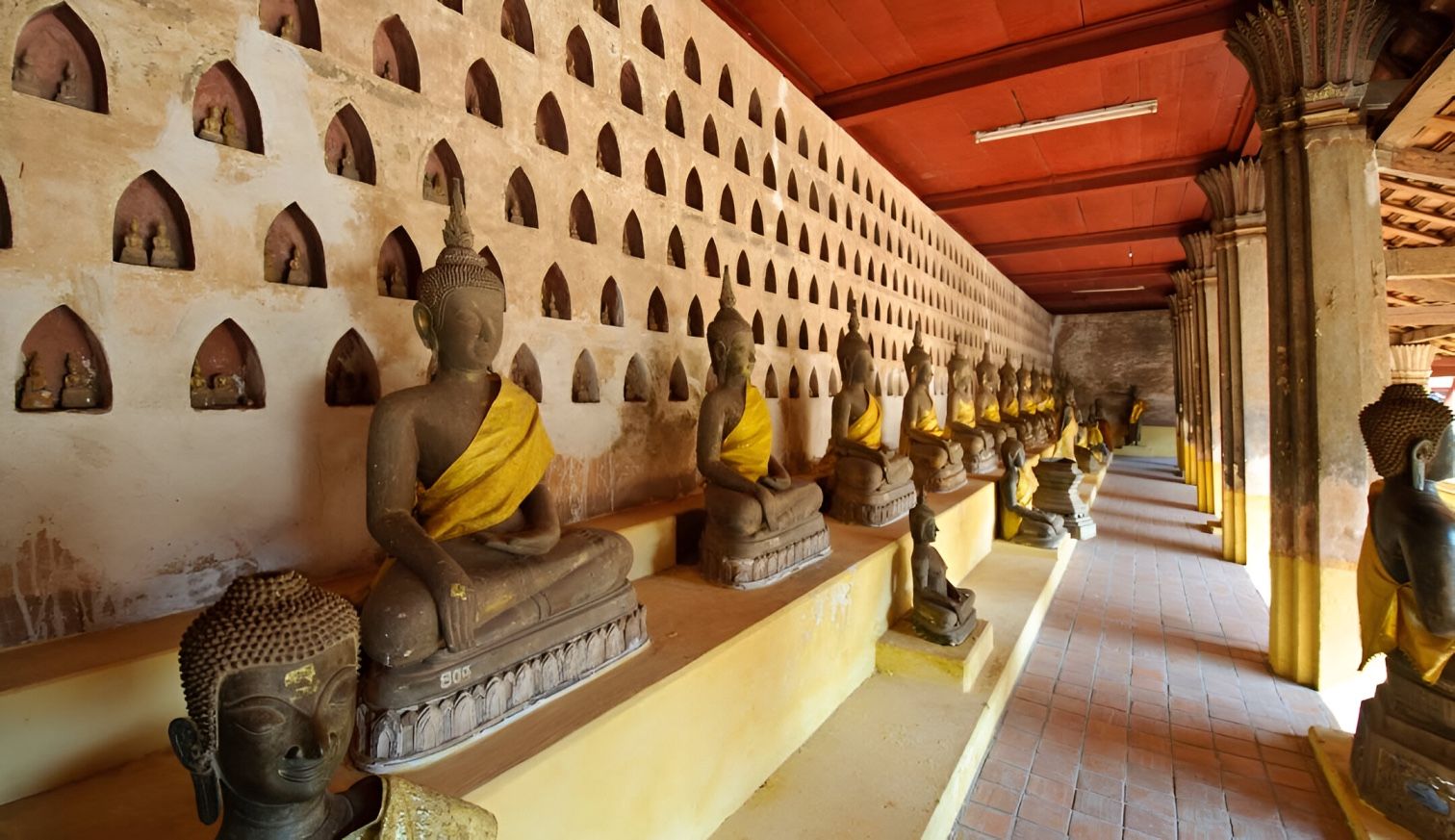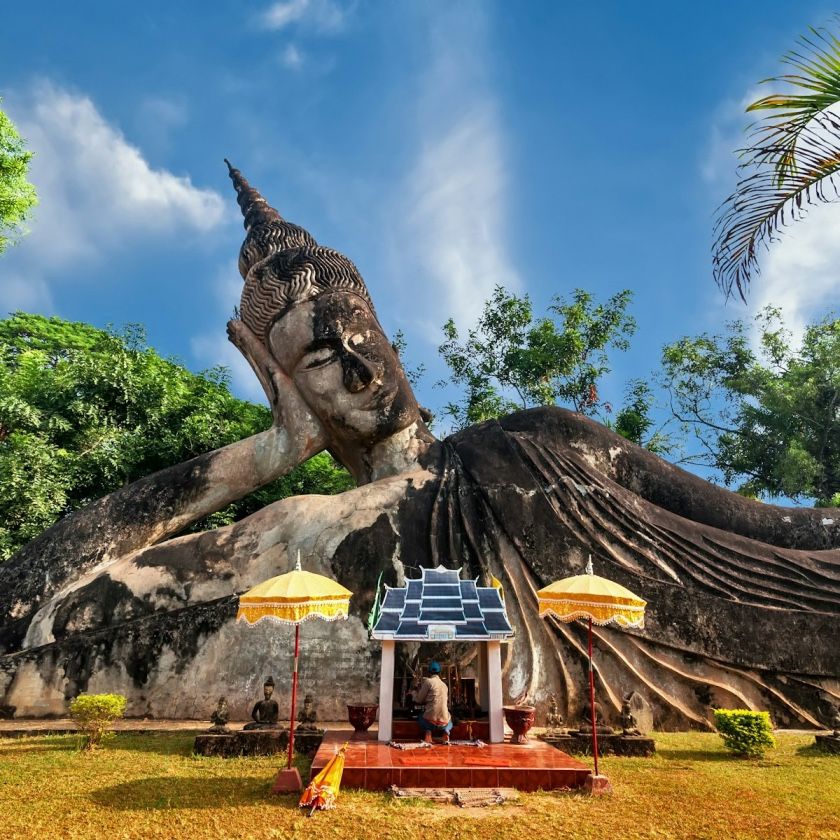Best Things To Do in Vientiane: Laos' Capital City
Vientiane capital city of Laos bend in the Mekong River amidst fertile alluvial plains. Despite its chequered past, Vientiane (pronounced ‘Wieng Chan’ ) is a laid-back city and home to interesting wats, lively markets, and a number of great activities and a handful of things to do.
Full of tourist attractions, Vientiane hosts the most important national monument in Laos: the Pha That Luang (the Great Sacred Stupa), symbolizes both Buddhism and Lao sovereignty.
Some of the must see things to do & sights of interest in Vientiane include Wat Pha Kaew, a former royal temple, which is now a museum; Wat Si Saket, the oldest temple in Vientiane; and the Morning Market, a sprawling collection of stalls which operate from 6 am to 6 pm. Wat Xieng Khuan is a collection of compelling Buddhist and Hindu sculptures located in a meadow, 24 km south of Vientiane.
Laos, typifies the traditional mystical images of South East Asia, a beautiful country with a great deal to offer. Check out Laos Private Tours
14 Top things to do in Vientiane, Laos
Vientiane is known as the laid-back capital city of Laos. Since life moves slowly here, it consequently attracts travelers who enjoy a peaceful, relaxed vibe. Additionally, this calm atmosphere makes Vientiane an ideal destination for those seeking tranquility. Among the best thing to do in Vientiane, explore centuries-old Buddhist temples on foot, by bicycle, or by tuk-tuk, making it one of the most popular activities in the Lao capital.
1. Patuxai monument
Reminiscent of the Arc de Triomphe in Paris, the Patuxai stands as Vientiane’s most prominent monument. The name translates approximately to Arch or gate of Triumph. Beyond a tourist attraction, Patuxai features four archways instead of two. Built in the 1960s with US-purchased cement intended for a new airport, it has earned the nickname ‘the vertical runway’.

2. Lao National Culture Hall
Opposite the Lao National Museum stands the monumentally proportioned Lao National Culture Hall, which dwarfs the museum. The Chinese government built an oversized and unattractive hall in the late 1990s as a ‘gift to the people of Laos’.
In addition of a tourist attraction in Vientiane, the hall hosts occasional cultural events, including French cinema, Lao classical dance, and beauty pageants. Since no publicly available schedule of events exists, you’ll need to keep a close eye on the Vientiane Times for announcements.
3. Phat That Luang
Top thing to do in Vientiane – This Svelte and golden, Pha That Luang stands as the most important national monument in Laos, symbolizing both Buddhist religion & culture. Legend says that Ashokan missionaries from India erected a tâht (stupa) here to enclose a piece of Buddha’s breastbone as early as the 3rd century BC.

4. COPE Visitor Centre
5. Wat Si Muang
The large sim, which was destroyed in 1828 and rebuilt in 1915, was constructed around the lák meuang and consists of two halls. The large entry hall houses a copy of the Pha Kaeo (Emerald Buddha) and a much smaller, somewhat melted-looking seated stone Buddha that is said to have survived the 1828 inferno.
6. Kaysone Phomvihane Memorial
7. Night Market
Once you done with sightseeing, spend an evening exploring the vibrant Vientiane Night Market by the Mekong River, which faces Thailand. Shop for souvenirs, enjoy local street food, or simply take a relaxing riverside stroll after dinner. If you’re not into shopping, the riverside walk offers a pleasant atmosphere, and the nearby mini amusement park adds a touch of fun. The Night Market of Vientiane runs daily from 6 PM to 10 PM, making it a perfect spot to experience the city’s nightlife and culture.

8. Wat Si Saket
Visitors can explore the beautifully preserved architecture and learn about its historical and spiritual importance. Wat Si Saket is open daily from 8 AM to 4 PM, and the entrance fee is approximately 10,000 LAK in 2025. A visit to Wat Sisaket offers a serene and enlightening experience, perfect for those interested in history and local culture.

9. Haw Phra Kaew (Ho Phra Keo)
Haw Phra Kaew, also known as Ho Phra Keo, is a must-visit site in Vientiane and a prominent museum of religious art in Laos. Originally built in 1565, it once housed the famous Emerald Buddha (Phra Keo), a jade statue now preserved in Bangkok. The museum showcases an extensive collection of religious artifacts, including intricately carved wooden statues, bronze Buddha images, and antique ceramics.
10. Presidential palace
11. Xieng Khuan: The Buddha Park
Xieng Khuan, also known as Buddha Park, is a must-visit attraction near Vientiane, Laos. Located 25km southeast of the city, this unique site features an eclectic collection of Buddhist and Hindu sculptures, crafted in 1958 by Luang Pu, a yogi-priest blending mythology and philosophy. Explore the quirky statues, capture stunning photos, and enjoy a relaxing stroll. Entrance fee: 15,000K. Opening hours: 8 AM–5 PM. Accessible via Bus 14 or tuk-tuk.

12. Lao textile museum
13. Stroll by sunset along the Mekong River
The Mekong River, Southeast Asia’s iconic waterway, offers some of the best things to do in Vientiane. Known for its stunning sunsets, this site is perfect for relaxing or enjoying fun activities. Take a Naga Boat cruise for breathtaking sunset views or dine at riverside restaurants like Tawan Riverside, Bor Pen Yang, Moon the Night, or Khong View. The scenic riverside walk and peaceful ambiance make it a must-visit sight for travelers seeking memorable Vientiane experiences.
14. Visit Lao Disabled Women’s Development Center
The Lao Disabled Women’s Development Center in Vientiane stands out as an inspiring attraction and a meaningful experience. This center empowers disabled women by teaching life skills, vocational training, and artistic crafts, enabling them to live independently. Visitors can shop for handcrafted products, supporting these women directly. For fun and educational activities, join classes in traditional Lao arts and techniques. This unique sight offers a fulfilling way to contribute while exploring Vientiane’s culture, making it one of the most rewarding things to do in the city.
Vientiane Travel Guide [Updated 2025]
If you’re looking for things to do in Vientiane, a full day is enough to visit the must-see sights. You can also extend your trip to explore more, including cafe-hopping and enjoying relaxing massages between temple visits and museum tours. Vientiane offers a great mix of cultural experiences and laid-back activities, perfect for a short yet fulfilling vacation in Laos. make sure to check Guide to Laos Travel for First Timers
Check if you need a Visa
Citizens from ASEAN member states (Brunei, Cambodia, Indonesia, Malaysia, Myanmar, Philippines, Singapore, Thailand, and Vietnam) can enter Laos without applying for a visa for up to 30 days stay. Travelers from countries like Japan, South Korea, Switzerland, Luxembourg, Russia, and Mongolia can stay visa-free for 15 to 21 days. For others, Laos offers a Visa on Arrival at entry ports or through an online application. Ensure you have passport photos, proof of accommodation, a US$50 fee, and possibly an outward-bound ticket. This visa grants 30 days of travel within Laos.
- Some African, Middle-Eastern are required to apply in person at the Lao embassies. Check with the neearest consulate before buying a flight ticket.
Travelling into Vientiane
Laos, a landlocked country, shares borders with Kunming (China) and Myanmar to the north, Vietnam to the east, Thailand to the west, and Cambodia to the south. The Mekong River, Southeast Asia’s longest river, flows through all six neighboring countries, offering a range of transport options.
1. Fly to Vientiane
You can easily fly to Vientiane, the capital of Laos, via Wattay International Airport, which offers direct flights from several countries. Scoot operates direct flights from Singapore to Vientiane three times a week (Tuesday, Thursday, and Saturday), with a flight duration of around 3 hours. Additionally, travelers can fly to Vientiane from Vietnam via Vietnam Airline, Thailand, Cambodia, China, and Korea, with several airlines providing regular international connections. These options make Vientiane a convenient destination to fly in from South-East Asian neighbors.
2. Train Travel
Train travel into Vientiane is an exciting option for travelers. The new Laos-China Railway reduces the journey from Kunming, China, to Vientiane to just 8 hours, a significant improvement over the previous multi-day trip. Booking tickets can be tricky, but many travelers prefer using services online.
Additionally, sleeper trains from Bangkok, Thailand, connect to Vientiane via the Friendship Bridge over the Mekong River, providing a comfortable and scenic option for reaching the capital of Laos.
3. Bus Travel
4. Boat
Boat travel into Vientiane offers a scenic and relaxing way to explore Laos. You can take a 2 days 1 night slow boat from Huay Xai, which cruises down the Mekong River to Vientiane. Tour operators provide hassle-free arrangements for this journey, which is a popular route for travelers coming from Chiang Mai, Chiang Rai, or Pai in Thailand.
5. Motorbike
6. Money & Credit cards
Cash remains the most widely accepted payment method in Laos, with USD and sometimes Thai Baht, or Vietnamese Dong accepted in some places. However, Lao Kip is preferred. If you need to exchange USD to Lao Kip, you can do so at banks, exchange counters, or ATMs. Some establishments accept credit cards, but they typically charge additional fees. ATMs are available throughout Laos, with the best rates often at Wattay International Airport. Remember to use your Lao Kip before leaving, as the currency has little value outside Laos. Check out Lao Kip, Currency of Laos
Travelling within Vientiane
1. From Airport to city
To get from Wattay International Airport to Vientiane by car or taxi, you can take a shuttle bus for 50k kip per person, operating from 8 AM to 8:30 PM. However, if you’re traveling with others, taking a taxi is more convenient and often cheaper per person. Taxis are readily available outside the airport, offering a faster and more comfortable option to reach your destination in Vientiane.
2. Ride Hailing/ Taxi Apps
In Vientiane, Laos, you can use ride-hailing apps like Loca and Xanh SM to book a taxi easily. Loca, similar to Grab or UBER, lets you book rides, pay for services, and even get takeaways, mostly in Vientiane and Luang Prabang. Xanh SM, on the other hand, operates its fleet of electric cyan taxis, offering a smooth ride. Make sure to download both apps and set up accounts before using them. Xanh SM accepts cash only.
Elephants themes items are also symbols of Thailand, appear in a variety of decor items. Options range from wooden carvings to decorative pillows, ensuring ample choices.
3. Rent Bicycles or Motorbikes
You can easily rent a motorbike or bicycle to explore Vientiane. Some hostels offer free bicycle to use, giving you a chance to enjoy the city at your own. However, be aware that Vientiane’s roads can be more congested and harder to navigate compared to the relaxed towns like Vang Vieng and Luang Prabang. If you prefer riding a bike, consider doing so on a Sunday when the roads are less busy for a more enjoyable experience.
Accommodations in Vientiane
Vientiane offers a variety of accommodation options to suit every budget. For budget-friendly stays, there are dorms and specially female dorms and ensures privacy in both 4-bed and 14-bed rooms. Other affordable hostels to consider are Nana Backpackers and TT Hostel, both with positive reviews.
If you’re looking for mid-range hotels, SYRI Boutique, Vientiane Boutique Hotel, and Centerpoint Boutique Hotel provide great value and are within walking distance of major attractions.
For a luxury hotel in Vientiane, La Seine Hotel offers a five-star stay, while the Crowne Plaza and Muong Thanh Luxury (Vietnamese brand), offer high-end options with pools for an elevated experience.
Best time to visit Vientiane
The best time of the year to visit Vientiane is during the dry season, which lasts from November to May, on the other hand, has more comfortable temperatures and less humid air. November and February of the following year are the busiest travel months because March through May is considered “boiling season” and should be avoided.
The weather in Vientiane follows the annual monsoon cycles that affect all of Laos & produce a ‘dry and wet monsoon climate’ with three basic seasons for most of Laos. The southwest monsoon arrives in Vientiane between May and July and lasts into November.
Tips for backpacking in Vientiane, Laos
Power Plugs
Laos, Including Vientiane capital, uses Type A, B, C, E & F outlets for power plugs and sockets. The standard voltage is 230V at a frequency of 50Hz. Yes, you need a power plug travel adapter for sockets type A, B, C, E and F in Laos. It is also advised to take a voltage converter. If you are traveling from North America or Europe, the power adaptor you use at home will accommodate plugs in Laos.
Medical services & healthcare
FAQ: Best Things to do in Vientiane, Laos
Is Vientiane safe for tourists?
Packing list for Vientiane
- Comfortable clothes and footgear for all seasons
- Lightweight and light-colored clothing for beating the sun
- Long pants or skirt to covering arms & legs (for visiting temples)
- Sweatshirt or light jacket for the cool seasons
- Powerful and long-lasting sunscreen
- Rain jacket in the wet seasons
- Dry pack if planning water-based activities
- Universal travel adaptor for Laos
- An Unlocked mobile phone to use a Lao sim-card
Tours that visit Vientiane, Laos

12 Day Active Adventure in Vietnam and Laos

Laos 7 day Tour





